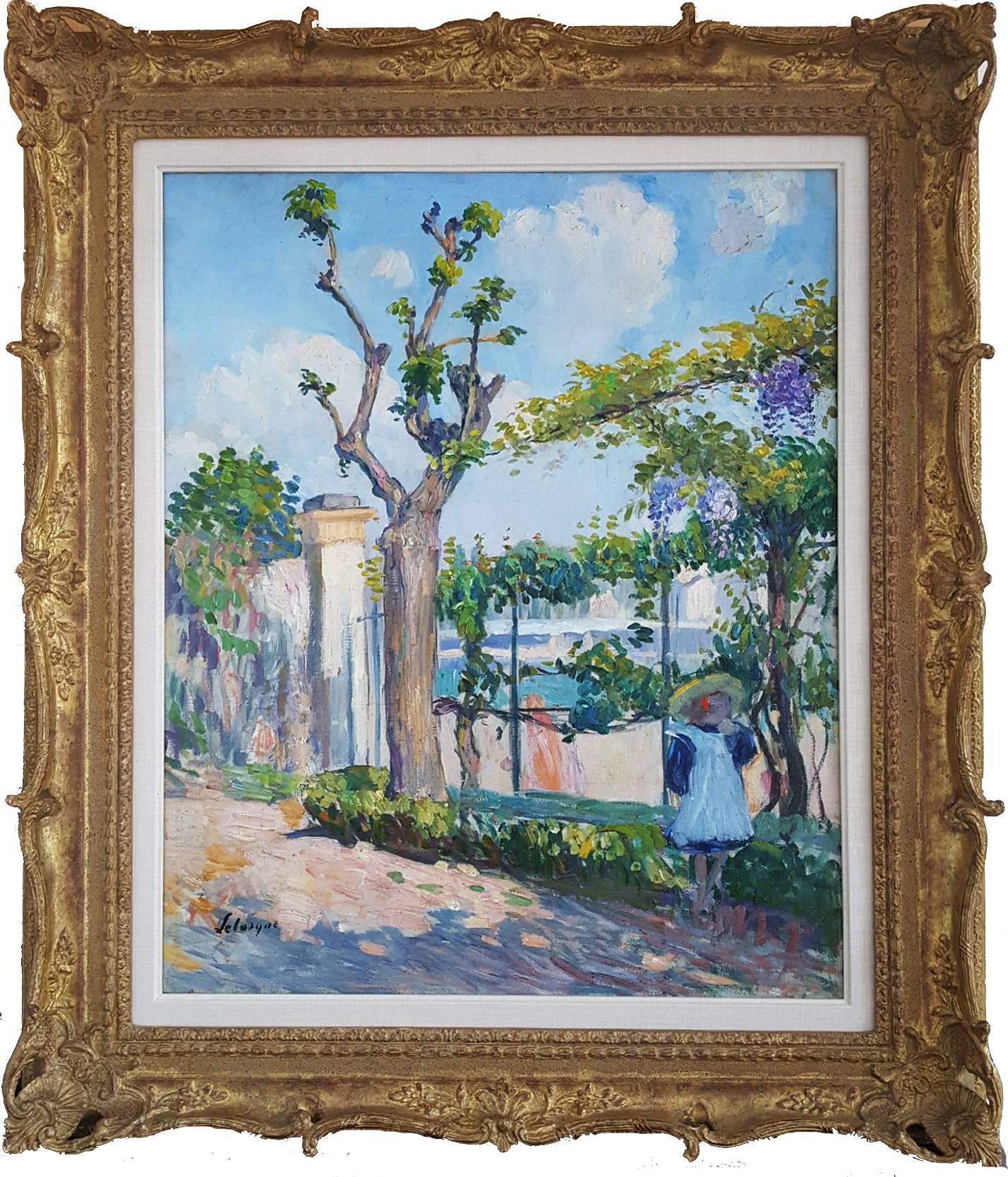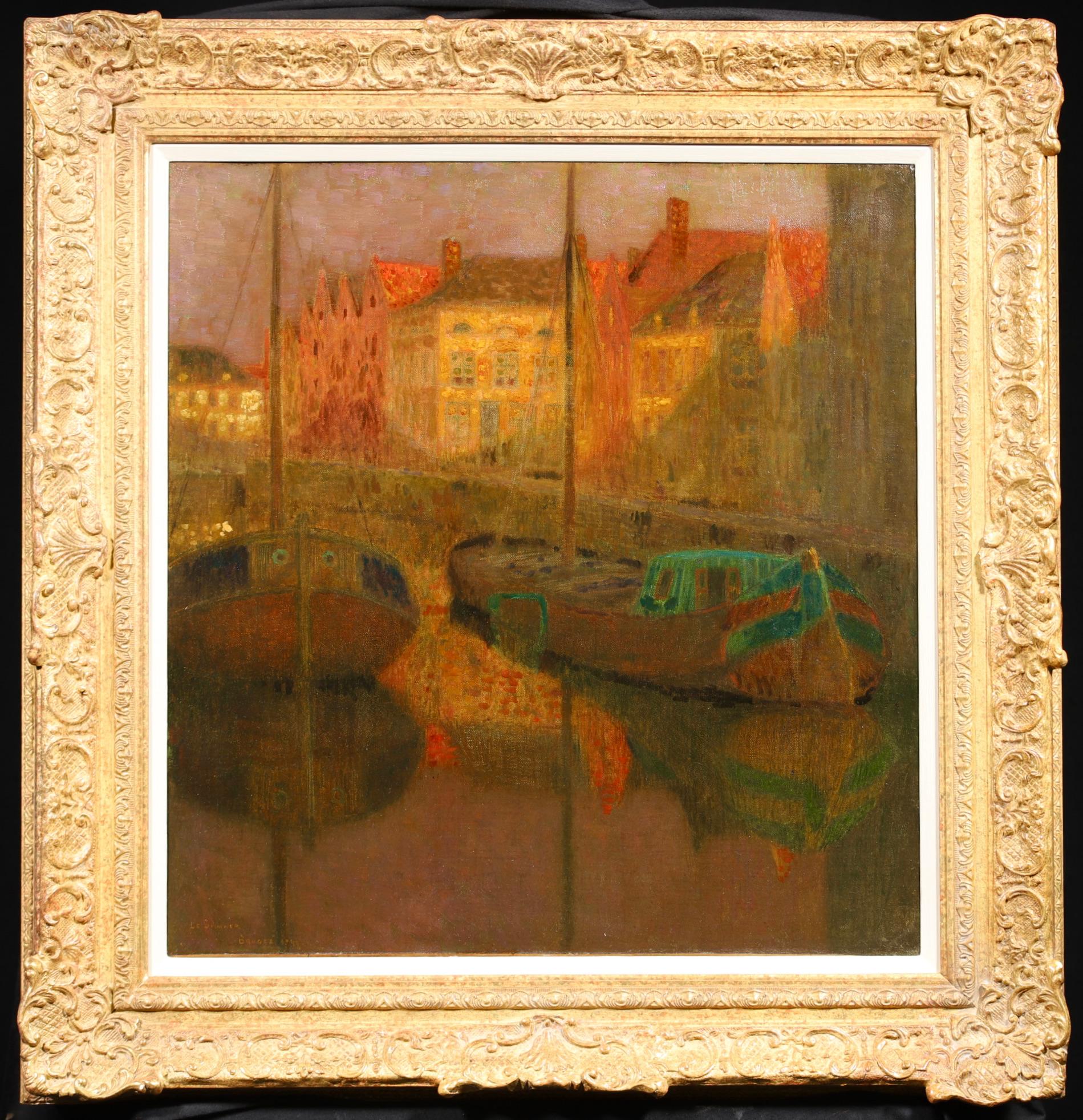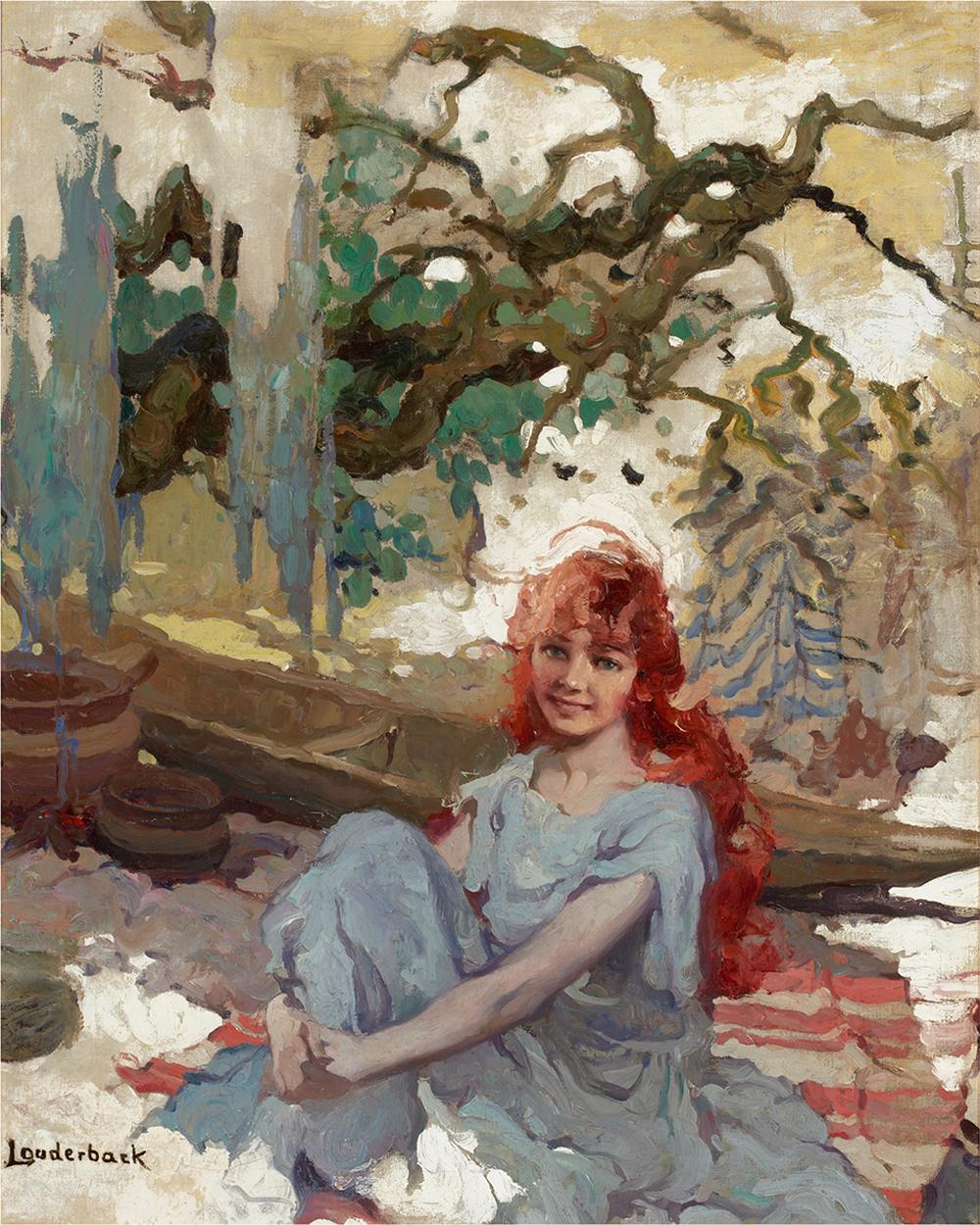Items Similar to The Harvesters - Post Impressionist Figures in Landscape Oil by Charles Frechon
Want more images or videos?
Request additional images or videos from the seller
1 of 16
Charles FrechonThe Harvesters - Post Impressionist Figures in Landscape Oil by Charles Frechon1908
1908
About the Item
Signed figures in landscape oil on canvas by French post impressionist painter Charles Frechon. The work depicts two woman harvesting a field on a sunny summer's day. One woman is resting against a hay bale.
Signature:
Signed lower left
Dimensions:
Framed: 27"x31"
Unframed: 20"x24"
Provenance:
Private collection - Rouen
Charles Fréchon joined the Académie de Peinture et de Dessin in Rouen in 1879 and met Joseph Delattre and Charles Angrand. He then went to Paris and in 1881 enrolled at the Académie Colarossi. When he returned to Rouen he painted mainly from life.Fréchon painted landscapes in an Impressionist style and was one of the instigators of the so-called School of Rouen. The School took its name from the fact that painters such as Joseph Delattre, Léon Jules Lemaître and Charles Angrand painted the region, working outdoors in opposition to the official aesthetic and sometimes adopting the Divisionist technique. Fréchon's banks of the Seine, fields under snow and orchards in blossom are executed in pale tones applied with small brushstrokes.
In 1887 the piece he sent to the Paris Salon was accepted. He began exhibiting in 1894 at the Salon des Indépendants and showed work at the Salon d'Automne from 1903. He also exhibited regularly in Normandy. His first solo exhibition was held in Paris by the Galerie Durand-Ruel in 1901. His work featured posthumously in 2003 at the group exhibition Around Impressionism: Nineteen Painters from the School of Normandy ( Autour de l'Impressionnisme: Dix-neuf Peintres de l'École Normande) at the Maison des Arts in Antony.
Museum and Gallery Holdings:
Louviers: The Pré aux Loups; Hillside in Beauvoisin; Boulevard Cauchoise; Forest Corner at St-Aignan
Rouen: Landscape; Spring Foliage
- Creator:Charles Frechon (1856 - 1929, French)
- Creation Year:1908
- Dimensions:Height: 27 in (68.58 cm)Width: 31 in (78.74 cm)
- Medium:
- Movement & Style:
- Period:
- Condition:Very good condition.
- Gallery Location:Marlow, GB
- Reference Number:
About the Seller
5.0
Platinum Seller
These expertly vetted sellers are 1stDibs' most experienced sellers and are rated highest by our customers.
Established in 2001
1stDibs seller since 2016
671 sales on 1stDibs
Typical response time: 3 hours
- ShippingRetrieving quote...Ships From: Marlow, United Kingdom
- Return PolicyA return for this item may be initiated within 3 days of delivery.
More From This SellerView All
- Barques de Peche - Post Impressionist Landscape Oil by Henri Le SidanerBy Henri Le SidanerLocated in Marlow, BuckinghamshireSigned post impressionist landscape oil on canvas by French painter Henri Le Sidaner. This stunning piece depicts two fishing boats moored in a fishing village at sunset. The last l...Category
1890s Post-Impressionist Landscape Paintings
MaterialsOil, Canvas
- Le Pont de Charenton - Post Impressionist Landscape Oil by Nathan GrunsweighLocated in Marlow, BuckinghamshireSigned post impressionist oil on canvas riverscape circa 1920 but Polish painter Nathan Grunsweigh. The work depicts a view of the bridge over the River Seine in Paris. A beautifully...Category
1920s Post-Impressionist Landscape Paintings
MaterialsCanvas, Oil
- Bathers on the Beach - Post Impressionist Landscape by Jacques-Emile BlancheBy Jacques Emile BlancheLocated in Marlow, BuckinghamshireSigned post impressionist oil on canvas landscape by French painter Jacques-Emile Blanche. The work depicts crowds of people enjoying a day at Brighton beach on the south coast of England. Bathers are dotted across the sandy beach with the pier on the right hand of the scene and the Grand Hotel behind. Signature: Signed lower right Dimensions: Framed: 29.5"x47.5" Unframed: 22.5"x39.5" Provenance: Private collection - Italy This work will be included in the catalogue raisonne of the work of Jacques Emile Blanche currently under preparation by Dr Jane Roberts & Muriel Molines Blanche received training from Gervex and Fernand Humbert. His grandfather was Émile Antoine Blanche, the psychiatrist who treated the poet Gérard de Nerval on several occasions. He was awarded a gold medal at the Exposition Universelle in Paris in 1900, and was a Commander of the Légion d'Honneur. He was well known in French and British artistic circles, and married the daughter of John Lemoine, the leader of the Diary of the Proceedings ( Journal des Débats), and author of the Life of Brummel. He exhibited his works in London and Paris. Blanche had a wide circle of acquaintances, and the list of portraits which he executed is indicative of the diversity of those who used to meet at his home: Henri Bergson; Stéphane Mallarmé; Henry Bernstein (1902); André Gide (1912); Anna de Noailles (1912); Jean Cocteau (1912); Igor Stravinsky (1915); Francis Jammes (1917); Paul Claudel (1919); Jean Giraudoux; Paul Valéry; Marcel Proust; Max Jacob (1921); Maeterlinck (1931); Debussy; Antoine Bourdelle; George Moore; André Maurois; François Mauriac; Maréchal Foch and the Princess de Broglie. He also wrote novels, which were more or less autobiographical, and essays, such as From David to Degas; Dates; From Gauguin to the Negro Review; Journals of an Artist ( De David à Degas; Dates; De Gauguin à la Revue nègre; Cahiers d'un artiste) in six volumes, and Manet. During meetings at his studio, he used to collect any snippets that would flesh out the essays he wrote, which alternated between being sharp and emotive. He gave them in series to the magazine Comoedia, under the title of Studio Talk. It was said that he aroused tremendous debate, notably with André Lhote, a painter younger than himself, who also doubled as a critic. The latter initially attempted to define the main characteristics of the art of the 'rebellious and charming Jacques Émile Blanche,' but subsequently treated him less generously, referring to a painter 'attached to the notion of 'high-and-mighty' genre painting.' He added that this sort of painting was marvellously illustrated by Manet. The quality of his flat surfaces, the precious greys and silvery light effects cause Jacques Émile Blanche to be compared more with Manet, whom he admired, than with the Impressionists, with whom he was compared in terms of his early works. Nevertheless, his outdoor backgrounds with traces of sometimes vivid colours have something in common with them. In the aftermath of World War I, he spent a long time on an enormous composition entitled Tribute to those who Died in the War. It was executed in a style which was totally different to his work as a whole. He offered this work to the church in Offranville near Dieppe. He also donated around 100 of his works to the Musée des Beaux-Arts in Rouen. He regularly exhibited in Paris, at the Salon of the Société Nationale des Beaux-Arts (also known as the Salon de Mars) from the time it was founded in 1890. At the time of the initial exhibitions held by the Société Nationale des Beaux-Arts, he rapidly gained fame by exhibiting such portraits as Paul Adam and Charles Cottet...Category
Mid-20th Century Post-Impressionist Landscape Paintings
MaterialsCanvas, Oil
- Les Grands Boulevards - Post Impressionist City Landscape Oil by Lucien AdrionBy Lucien AdrionLocated in Marlow, BuckinghamshireSigned figures in landscape oil on canvas circa 1920 by French post impressionist painter Lucien Adrion. The painting depicts people going about their daily lives on the streets of P...Category
1920s Post-Impressionist Landscape Paintings
MaterialsCanvas, Oil
- Paris - Post Impressionist Landscape Painting - Antoine BlanchardBy Antoine BlanchardLocated in Marlow, BuckinghamshireSigned post impressionist figures in cityscape oil on canvas circa 1960 by French painter Antoine Blanchard. The work depicts a bustling scene at Place de la Republique - a square in...Category
1960s Post-Impressionist Figurative Paintings
MaterialsCanvas, Oil
- Le champ de coquelicots - Post Impressionist Landscape Oil Painting - Marcel DyfBy Marcel DyfLocated in Marlow, BuckinghamshireSigned oil on canvas figures in landscape by sought after French post impressionist painter Marcel Dyf. The work depicts workers picking flowers in a poppy field in St Paul de Vence,...Category
1950s Post-Impressionist Landscape Paintings
MaterialsCanvas, Oil
You May Also Like
- Bords du Loing by Alfred Sisley - Oil, landscape paintingBy Alfred SisleyLocated in London, GB*THIS PRICE INCLUDES 5% IMPORT DUTY APPLICABLE IF THE WORK REMAINS IN THE UK ONLY. Bords du Loing by Alfred Sisley (1839-1899) Oil on canvas 46.1 x 55.7 cm (18¹/₈ x 21⁷/₈ inches) S...Category
1890s Post-Impressionist Landscape Paintings
MaterialsCanvas, Oil
- Le Jardin de Lagny - Garden with young girl Post-impressionistBy Henri LebasqueLocated in Miami, FLLe Jardin de Lagny Provenance: Arthur Tooth, London Radon Gallery, NY This beautiful evocation of a lyrical French landscape is a fine example of of Po...Category
Early 1900s Post-Impressionist Landscape Paintings
MaterialsOil, Canvas
- Girl with canoe painted in Arts and Crafts styleBy Walt LouderbackLocated in Miami, FLSigned lower left. Most likely for Saturday Evening Post or Colliers. Louderback is a painter/illustrator of the Golden Age of Illustration...Category
1920s Post-Impressionist Figurative Paintings
MaterialsCanvas, Oil
- Haystack with Resting FiguresBy John Maclauchlan MilneLocated in Hillsborough, NCScottish artist John Maclauchlan Milne, RSA, (1885-1957) is a contemporary of Scottish Colourists Peploe, Fergusson, Cadell and Hunter. Like the...Category
1920s Post-Impressionist Landscape Paintings
MaterialsCanvas, Oil
- Henri-André Martin, Les Baux de Provence, Oil on Canvas, 1961By Henri-André MartinLocated in Saint Amans des cots, FROil on canvas by Henri-André Martin (1918-2004), France, ca.1980s. Les Baux de Provence. With frame: 71x98 cm - 28x38.6 inches. Without frame: 65x92cm - 25.6x36.2 inches. 30P format. Signed lower right "Henri A Martin" (see photo). Located and dated 1961 on the back (see photo). Can be matched to make a pair with another painting by Henri-André Martin that we offer on 1stdibs whose title is "Henri-André Martin Olive Tree Field in the Alpilles, Provence, Oil on Canvas". Born in Lyon in 1918, the child and the adolescent Henri-André Martin spent his youth in Saint-Étienne, his father, Edme Martin, first installed as a practicing doctor in Lyon, having been appointed doctor of the anti-tuberculosis dispensaries of the Loire. During his first years of studying medicine in Lyon, he nevertheless enrolled in the Beaux-Arts. Appointed hospital intern upon his return from captivity in 1942, he ended his medical career as director of the otolaryngology university clinic at Édouard-Herriot hospital. But painting was his passion. Painting was for Henri-André Martin the way of expressing his feelings. By nature very reserved and of an extreme modesty that many took for coldness, it was what allowed him to express his strong artistic sensitivity and, his pictorial periods are as many reflects of his anxieties, of his hopes, of his joys. At every period of his life, wherever he goes and whenever he has a moment, he paints gouaches, often of small size, but sometimes of larger size. He also paints beaches that have been compared to those of Boudin. Their invoice shows, however, that this figure is only appearance and that in fact, these beaches made of water, sky and sand, readily dispense with the motif, the work of the material seeming to have more importance. as the subject. Despite the fact that until the 1970s he painted "on the ground", his canvases remain far removed from the anecdote. Often harsh like the landscapes of Provence, the Parisian walls which express concern, or the railways, the switch tracks which suggest, in ocher and black, all the embarrassment of choice. We find the same nostalgic gravity in the canvases of the carcasses of boats which, as his friend Louis Pons later wrote, "seem to die of immobility" or in the canvases of Venice, or the landscapes of Eygalières. In the following years, his painting became simpler, more synthetic, such as these landscapes with tortured almond trees, black and gnarled olive trees, plane trees standing out against the ocher sky of the dawn of Provence, in winter. These are also the canvases of Hamburg in the dough becomes heavier, the colors darken, marking all the gravity of the port landscapes. Workshop work gradually takes precedence over motif painting. The pivotal period coincides with that of his work on the olive tree, during which he leads the realization of the "Trunks", a collection of six lithographic plates, of the book L'olivier comprising many lithographs and serigraphs, but also texts. poetic and numerous paintings. He then became passionate about everything related to the olive tree (literature, painting, traditions, history), but also to the tree itself, its thousand-year-old history, its poetry, its symbols, but also its culture, its size. oil production...Category
1960s Post-Impressionist Figurative Paintings
MaterialsCanvas, Oil
- Notre-Dame de Paris, Oil on Canvas by Henri André MartinLocated in Saint Amans des cots, FROil on canvas by Henri-André Martin (1918-2004), France, ca.1960. Notre-Dame de Paris. With frame: 79.3x 60.3 cm - 31.2x23.7 inches. Without frame: 54x 73 cm - 21.3x28.7 inches. 20P format. Signed lower left "Henri A. Martin" (see photo). Born in Lyon in 1918, the child and the adolescent Henri-André Martin spent his youth in Saint-Étienne, his father, Edme Martin, first installed as a practicing doctor in Lyon, having been appointed doctor of the anti-tuberculosis dispensaries of the Loire. During his first years of studying medicine in Lyon, he nevertheless enrolled in the Beaux-Arts. Appointed hospital intern upon his return from captivity in 1942, he ended his medical career as director of the otolaryngology university clinic at Édouard-Herriot hospital. But painting was his passion. Painting was for Henri-André Martin the way of expressing his feelings. By nature very reserved and of an extreme modesty that many took for coldness, it was what allowed him to express his strong artistic sensitivity and, his pictorial periods are as many reflects of his anxieties, of his hopes, of his joys. At every period of his life, wherever he goes and whenever he has a moment, he paints gouaches, often of small size, but sometimes of larger size. He also paints beaches that have been compared to those of Boudin. Their invoice shows, however, that this figure is only appearance and that in fact, these beaches made of water, sky and sand, readily dispense with the motif, the work of the material seeming to have more importance. as the subject. Despite the fact that until the 1970s he painted "on the ground", his canvases remain far removed from the anecdote. Often harsh like the landscapes of Provence, the Parisian walls which express concern, or the railways, the switch tracks which suggest, in ocher and black, all the embarrassment of choice. We find the same nostalgic gravity in the canvases of the carcasses of boats which, as his friend Louis Pons later wrote, "seem to die of immobility" or in the canvases of Venice, or the landscapes of Eygalières. In the following years, his painting became simpler, more synthetic, such as these landscapes with tortured almond trees, black and gnarled olive trees, plane trees standing out against the ocher sky of the dawn of Provence, in winter. These are also the canvases of Hamburg in the dough becomes heavier, the colors darken, marking all the gravity of the port landscapes. Workshop work gradually takes precedence over motif painting. The pivotal period coincides with that of his work on the olive tree, during which he leads the realization of the "Trunks", a collection of six lithographic plates, of the book L'olivier comprising many lithographs and serigraphs, but also texts. poetic and numerous paintings. He then became passionate about everything related to the olive tree (literature, painting, traditions, history), but also to the tree itself, its thousand-year-old history, its poetry, its symbols, but also its culture, its size. oil production...Category
1960s Post-Impressionist Landscape Paintings
MaterialsCanvas, Oil




